In semi-darkness, I make my way down a tunnel-like corridor, treading barefoot on the cold stone floor. Fifty figurines of the Buddha, five feet tall and remarkably lifelike, flank one side of the vaulted chamber, eyes cast downward in contemplation, each painted face subtly individuated—broad or slender noses, smiles or frowns, chins pointed or rounded. A shaft of natural light at the far end of the passage softly illuminates their serene expressions, broad chests and graceful hands. Across the corridor sit hundreds of Buddha miniatures, each sheathed in gilt, resting on black obsidian bases that teeter on two tiers of sandstone. I turn a corner and enter a second gallery; it’s decorated with bas-reliefs of water buffaloes, elephants, horses, jackals and peacocks. A giant sculpted serpent eternally slithers along the base of the wall.
I’m deep inside a magnificent Buddhist temple in the ruined city of Mrauk U in western Myanmar (formerly Burma), in embattled Rakhine State. Beginning around 1535, a thousand workers labored for a year to construct the thick, nearly windowless walls, cutting massive sandstone blocks and fitting them together so skillfully without mortar that they still hold together.
/https://tf-cmsv2-smithsonianmag-media.s3.amazonaws.com/filer/34/8a/348ad27a-0f51-4a6a-b2d1-24cc08d6dd94/c_budha_dyptic.jpg)
Right, a ten-foot-tall statue of the Buddha looms inside Shitthaung temple, built in the 1500s by King Man Pa to celebrate campaigns in eastern Bengal. Hemis / Alamy
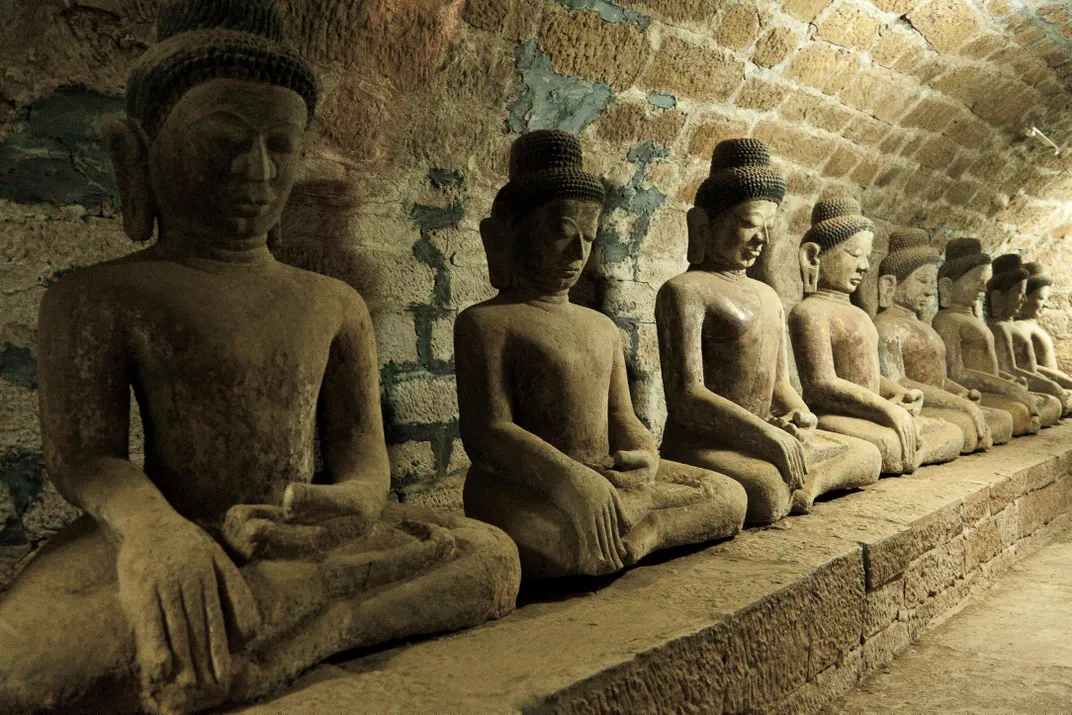
It is said that Man Pa, king of ancient Arakan for nearly 20 years, erected the temple to celebrate a naval victory over a Portuguese armada and a military campaign against cities across the Bay of Bengal. He adorned the roof with 27 bell-like stupas, or domed Buddhist shrines, enclosed the inner sanctuary in a maze of corridors, and crammed the complex with 80,000 representations of the Buddha in various incarnations. These include real and imaginary animals; bodhisattvas, human beings delaying entry to nirvana in order to alleviate the suffering of others; demigods; protective spirits; and scenes from the Jataka tales, ancient allegories from the Indian subcontinent, built around the past lives of the Buddha. Lording over the panoply is a colorful painted-stone relief of Man Pa himself, a slender, godlike figure wearing a gilded robe and three-tiered golden crown shaped like a pagoda. He stands balanced atop an elephant, surrounded by adoring members of his court. The variety and richness of the images are astonishing, and attest to both the king’s piety and ego.
With my translator and guide, Zaw Myint, a teacher of English, I go deeper into the temple, called Shitt-haung, and enter its heart: the ordination hall, consecrated for ritual ceremonies such as the upasampada, the undertaking of an ascetic life in the manner of the Buddha. Carvings of leering trolls loom on the lintel, warding off evil spirits. At the far end of the room, squeezed into an arched niche, is a ten-foot-tall seated Buddha with immense earlobes and a richly folded tunic, all encased in gold leaf. Direct sunlight pierces a narrow aperture, bathing the figure in what seems like a divine aura; a halo painted vibrant blue, green, red and yellow encircles the Buddha’s head.
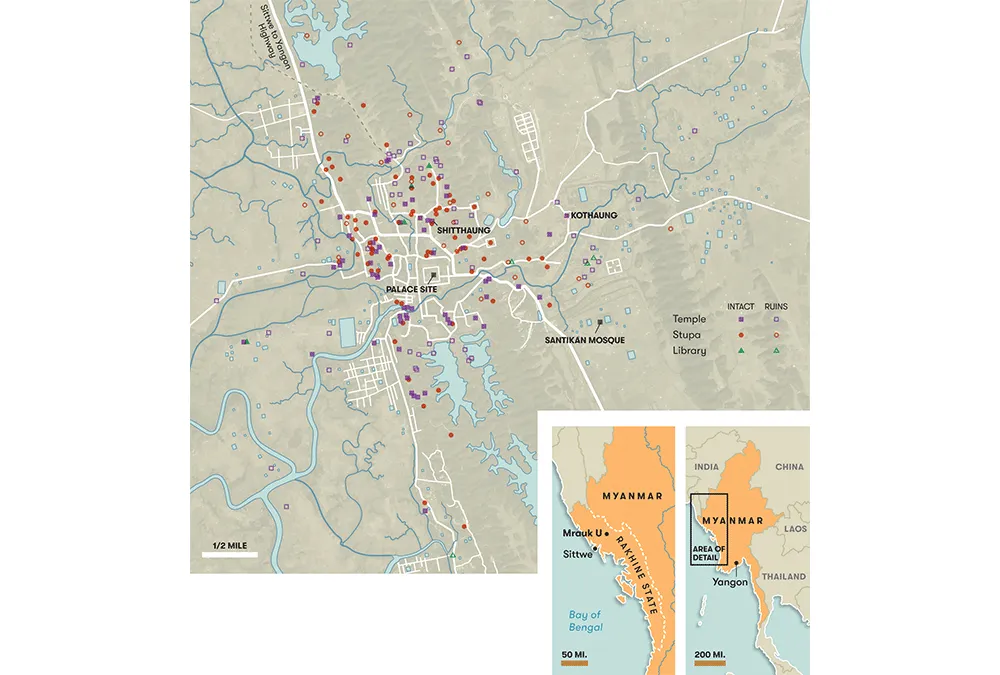
A corridor leads into the meditation room, each niche in the walls drilled with deep holes to eliminate echoes and avoid disturbing the king’s contemplations. A sculpted footprint of the Buddha, as well as friezes depicting the Hindu elephant-headed god Ganesh and the supreme Hindu deities Rama and Vishnu, amplify the chamber’s sanctity. “Everyone was welcome here, but often the king came to seek meditation alone,” says Zaw Myint.
* * *
In a shrinking world, the rediscovery of a remote and fabled city is nothing short of miraculous. And few abandoned civilizations have excited the human imagination as much as Mrauk U. It was the power and mystery of this place, tucked away in the Burmese jungle and almost completely forgotten, that lured a French historian, Jacques P. Leider, a quarter-century ago, shortly after the military dictatorship began to open the isolated country to the world. The experience, he says, turned a nagging curiosity into a lifetime obsession.
Now others have begun to share Leider’s fascination. Through early 2019, historians, hydrologists, archaeologists and reconstruction experts, under the auspices of the government of Myanmar with United Nations support, visited this city on a near-monthly basis. Bouncing over dusty roads, crossing rice paddies and climbing up disintegrating hillside trails in the heat, the teams went searching for abandoned glories scattered across the sleepy rural landscape. Some experts believe that Mrauk U is as emblematic of artistic and architectural achievement as Bagan, the ancient Burmese capital on a plain alongside the Irrawaddy River that contains the world’s greatest concentration of Buddhist temples, pagodas and stupas. But while Bagan draws more than a quarter-million foreign visitors a year, barely 2,000 foreigners made their way to Mrauk U in 2016—only about six a day.
Two elements make Mrauk U unique: exquisite Buddhist temples constructed largely from stone, and a network of military defenses that utterly transformed the hilly, flood-prone landscape into a fortress city. “There is nothing comparable to it,” says Massimo Sarti, a Unesco consultant hydrologist from Italy, who is helping to support documentation of Mrauk U. (Another collaborating entity is China’s Nanjing University.) A 2017 commission chaired by former U.N. Secretary General Kofi Annan recommended expediting Myanmar’s long-standing nomination of Mrauk U as a Unesco World Heritage site, calling it “the greatest physical manifestation of Rakhine’s rich history and culture.”
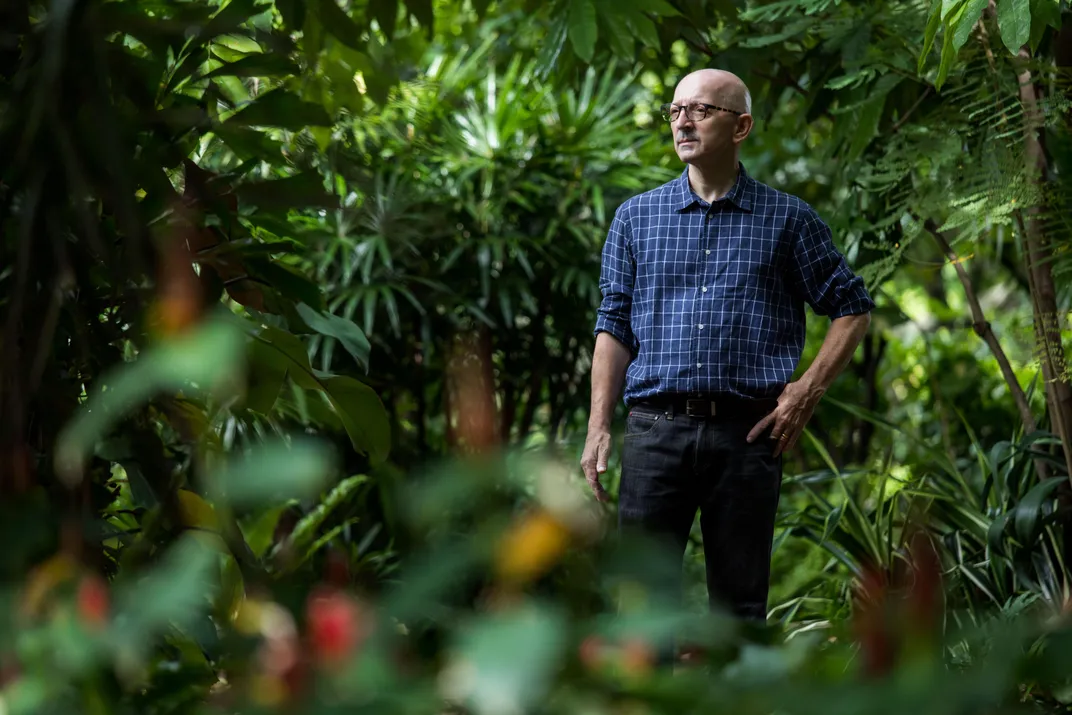
The life of Mrauk U spanned roughly 350 years, from approximately the 1430s to 1780s, when it was the capital of Arakan, an independent kingdom that at times extended more than 400 miles along coastal plains and mangrove marshlands bordered by the Bay of Bengal. Built on a hilly plateau above two river valleys, and offering easy access to the sea, the walled city was known for its heterogeneity and cross-cultural fertilization. Muslims and Buddhists served side by side in the royal court and the bureaucracy. Dutch, Portuguese, Chinese and other foreign merchants dwelled in their own prosperous quarter, trading spices, textiles, opium, iron, tobacco, sulfur and pepper for rice and ivory. Japanese samurai and soldiers from the Mogul empire guarded the Royal Palace.
The king held court in a hall decorated with carved and gilded teak pillars, receiving a stream of diplomats, courtiers and foreign messengers bearing gifts. “The room of the bejeweled throne is crowded, and Candrasudharma presides in a kingly manner,” the Bengali poet Alaol wrote of the monarch at the time of his visit in the 1660s, when Mrauk U was at its zenith. “The noble counsellors wear...divine clothes full of fragrances....All the messengers wear many beautiful clothes, musk, aloes and sandal[s].” The Augustinian friar Sebastien Manrique, who lived in the capital during the early 1630s, wrote of vast palace rooms “made of odoriferous woods...which thus gratify the sense of smell by their own natural fragrance. There was one room known as ‘the House of Gold’ for being entirely ornamented from top to bottom in that metal.” The city, said Alaol, “is a matchless place on earth.”
Those glory days ended in 1784, when Burmese invaders crossed the range of hills dividing their kingdom from Arakan and conquered Mrauk U after several months. The soldiers marched the king and his family, with other members of the elite, into captivity. Mrauk U was left to molder. The British, who seized Arakan in the First Anglo-Burmese War in 1824 and ruled until 1948, had developed an interest in Burmese archaeology during the Victorian era and supported local restoration of the Shitthaung temple in the late 1800s. But World War II and its aftermath derailed those efforts, and successive Burmese military regimes cut off the country from the rest of the world. Through most of Myanmar’s independence, “the city attracted zero interest” from historians or preservationists, says Leider, who heads the École Française d’Extrême-Orient in Yangon.
Now, as the United Nations focuses attention on a city once known for its harmony and religious tolerance, Mrauk U has become a flash point amid the ethnic struggle raging in Rakhine State. A bloody rampage by the army in August 2017 against the stateless Muslim minority known as the Rohingya left thousands dead and drove 700,000 out of the country—most to Bangladesh. (The killings occurred after a Rohingya rebel group had attacked the army.) Long shunned as illegal migrants, the Rohingya now wait in exile, while the international community attempts to negotiate their return to Myanmar. The emerging understanding of Mrauk U, whose history reflects Islam’s long presence in the region—a history that some Buddhists continue to deny—has given powerful momentum to the Rohingyas’ demand for citizenship and equal rights.
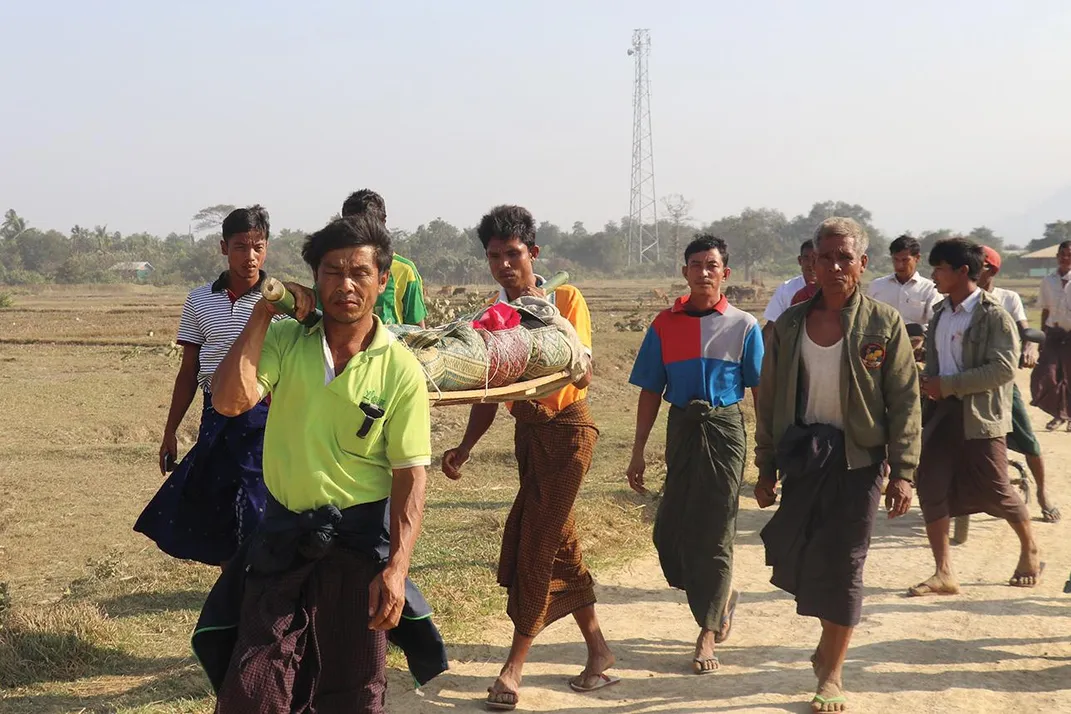
Rakhine’s Buddhists also claim ties to the ancient capital. Mrauk U was the center of their unique heritage, violently extinguished by the Burmese conquerors. A separatist group called the Arakan Army has declared war on the Myanmar military. Bloody clashes have erupted near Mrauk U town and the temples, disrupting efforts by international researchers to survey the priceless evidence of the people who flourished here some 500 years ago.
* * *
Any effort to raise the global profile of Mrauk U entails a grueling slog through equatorial heat. One December morning, Zaw Myint and I followed a caravan of four-wheel-drive U.N. vehicles down dusty roads to the northern edge of the city. Elderly men wearing conical straw hats, herding their cattle through pastures, stopped to watch the convoy roll past. We parked the cars by the side of the road. Under a blazing sun, we trailed a Unesco team on foot over narrow dikes crossing dry and fallow paddies, then hiked down a dirt trail past betel nut fields and chili plantations. A drone whined and darted like an outsized insect overhead. Somewhere above us, a single-engine plane was using LIDAR technology to penetrate patches of forest and capture images of structures that have long lain undetected beneath the dense foliage.
After a 45-minute trek, we arrived in front of a 30-foot-tall square brick platform rising over the lush fields. “We think that this dates to the 16th century,” said U Than Myint (no relation to my guide), a local historian and director of the Mrauk U Heritage Trust, a private restoration group. He explained that the kings of Mrauk U, constantly worried about attacks from Mogul governors of Bengal across the bay and the Burmese to the east, built ramparts between the hills that ringed the city, along with fortresses and guard posts fortified by cannons. They further protected their city with a network of reservoirs, sluices, spillways, canals and moats—used for irrigation and flood control during peaceful times, and for military defenses in war. In the 16th century, Man Pa opened sluices in the reservoirs and allowed water to gush through spillways, drowning Burmese assailants and turning back an attempted invasion.
Much of those waterworks are gone now, the old ramparts hidden by jungle growth or buried under cultivated fields; the canals silted over long ago. But international efforts have been gradually peeling back the layers, exposing the structures and describing the scale of the city. “There are pagodas and stupas, ancient wells, ceramic kilns, walls and water gates, and canals and lakes. All these belong to the Mrauk U culture,” Sarti told me, consulting a topographical map tracing the ancient ramparts and waterworks in different colors. “We’re building up a dossier, with the goal of restoring as much of it as possible. We want to bring it back to life.”
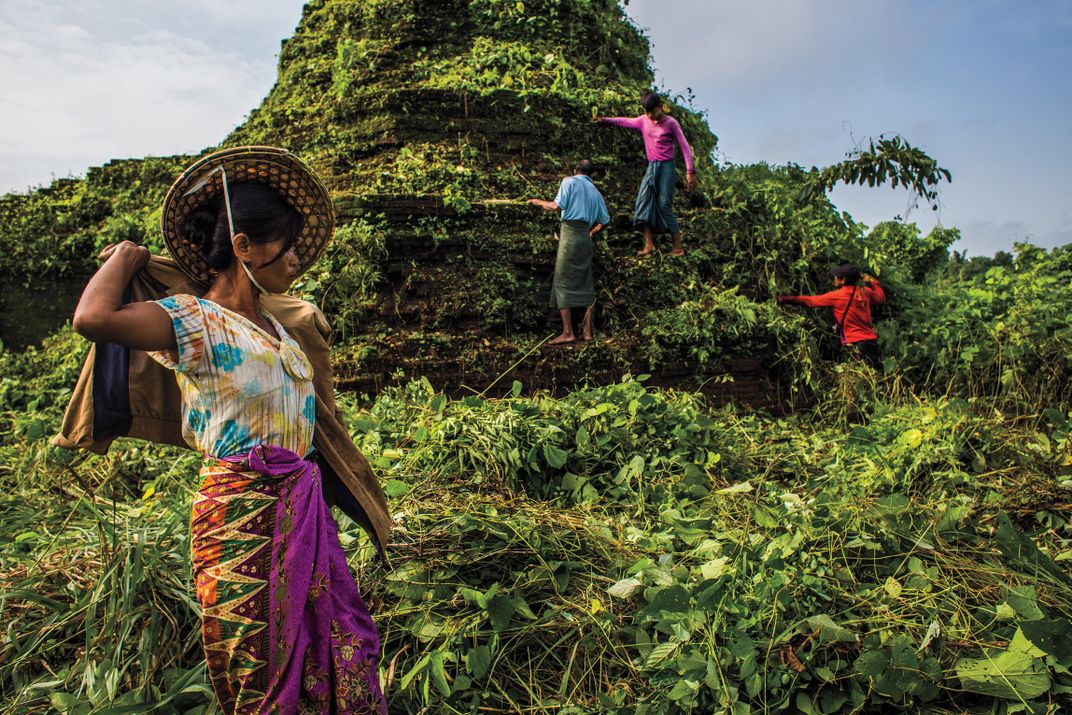
Just a stone’s throw away from the crumbling garrison, rising over rice paddies stretching into the distance, lies the largest and what many consider the most ambitious temple in Mrauk U: Kothaung. In a gesture of filial one-upmanship, Man Pa’s son and successor, Min Dikkha, who ruled the Arakan Kingdom for three years, built the structure over six months in 1553. He topped it with a six-story stupa and filled it with 90,000 sculptures and reliefs of the Buddha—10,000 more images than the temple built by his father contains.
I climbed five receding terraces flanked by hundreds of smaller stupas, entered the shrine, and followed ornate vaulted corridors crisscrossed by shafts of light and spiraling toward an inner chamber. The carved faces of hideous ogres guarded every doorway. The walls at first appeared to be covered with indecipherable inscriptions. Closer inspection of the engravings revealed them to be tiny carvings of the Buddha, some no larger than postage stamps, covering every inch of the sandstone surfaces, the walls broken at regular intervals by pedestals. On each platform sits a Buddha in the classic Bhumisparsha mudra position. His right hand reaches over his right knee toward the ground—a gesture said to capture the precise moment of his spiritual awakening and his designation of the earth as witness to his enlightenment.
Though still splendid in places, Kothaung has deteriorated badly over the centuries. Unlike Shitthaung, which was embraced by locals and restored by the Burmese military, Kothaung disintegrated, largely forgotten, in an isolated part of the city. Jungle growth completely covered it until 1996, when the regime began to authorize clearing of the vegetation. Since then little restoration has been accomplished. Much of the roofing has collapsed, exposing row upon row of Buddha figurines to the elements. Buried under heaps of roofing tiles, stones, bricks and other debris, many of the sculptures have toppled off pedestals. Others are missing noses and ears, or have been smashed into stumps. According to legend, the damage was caused by lightning bolts sent down as punishment to Min Dikkha for his attempt to surpass his father’s achievement.
* * *
Jacques Leider began studying the history of Arakan as a graduate student in the 1980s, during the darkest years of the Burmese military dictatorship. Not much was known. He was entirely dependent for information on a handful of photographs and articles, plus early 19th-century correspondence inscribed on palm leaves, then copied onto bound paper volumes, gathered by an English wine trader and administrator for the British East India Company in Arakan; those records are now stored at the Bibliothèque Nationale in Paris. “The internet didn’t exist, nobody knew how Mrauk U looked,” Leider told me over a rice and chicken-curry dinner at the Mrauk U Hotel, a cluster of rustic bungalows on the town’s main road, after a long day exploring the ruins in the heat. I had encountered him briefly with other Unesco consultants on top of an ancient stone fortress on the edge of Mrauk U that afternoon, but this was our first opportunity to talk one-on-one. “It was one of the most isolated places in a self-isolating country. I was working blind for seven years.”
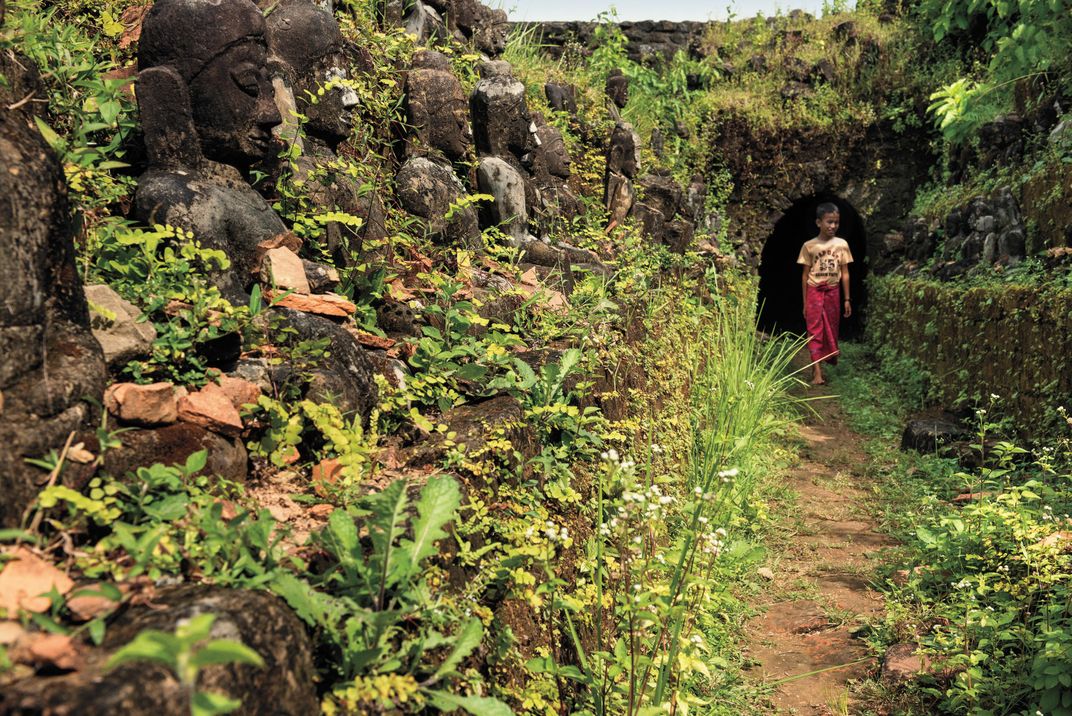
In early 1994, the cash-strapped military dictatorship, sensing tourism possibilities, cautiously opened the area to foreigners. Exhilarated at the prospect of seeing Mrauk U for himself, Leider boarded a flight in Yangon at the height of the rainy season, flew to Sittwe, the capital of Rakhine State, and took a ferry at dawn up the Kaladan River for six hours—the only way to travel to Mrauk U in those days. The boat chugged through dense morning fog, which cleared from time to time to reveal ancient pagodas looming above the river. A bicycle rickshaw took him to a dilapidated guesthouse, which had only candles for illumination: The town had two hours of electricity each week and no plumbing. A plastic bottle of drinking water was a rare commodity. “I knew all the names of the temples, but never having been in Mrauk U, I didn’t know where they were,” he recalls. A one-eyed schoolteacher guided him around the ruins on his bicycle, “telling me stories about temples and kings that I’d never read about.”
Leider visited Shitthaung, the temple most revered by local residents, and then entered the adjacent hilltop temple, Htukkanthein, a near-windowless fortress built in 1571 by king Min Phalaung and topped by a mushroom-shaped crown, or hti. “It was a mysterious place, linked to black magic,” he recalled. Leider groped with a candle along mazelike corridors, at last finding the ordination chamber, where he gazed upon a golden Buddha illuminated by a beam of sunlight. It was a perfect symbol, Leider thought, for man’s journey through darkness to enlightenment.
As he made his way out, he encountered a group of young people playing guitars and singing Burmese pop music, which he took as a sign of the cross-generational power of Mrauk U’s sacred sites. He left Mrauk U with a feeling of wonder, and the satisfaction of being one of the very first academics to see the place in decades. “You don’t run into 75 scholars who have done work on this,” he told me.
Leider returned to Europe and, later, took a teaching position at Chulalongkorn University in Bangkok, Thailand. Pursuing his doctorate on the history of Mrauk U, he revisited the city in 1996, 1997 and 1998. Back in European libraries, he combed through the records of a Dutch surgeon, an Augustinian missionary and others who had lived in Mrauk U during its glory days, witnesses to its heterogeneous population.
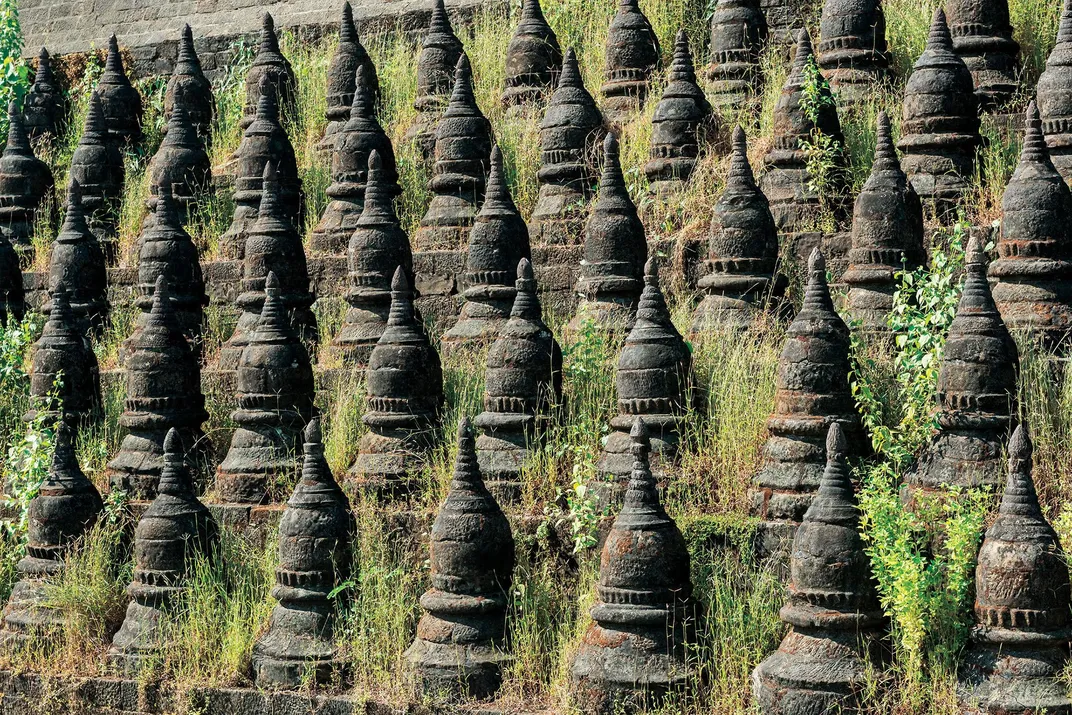
Arakanese kings are said to have used Muslim-inspired titles such as “shah,” and they stamped coins with Arabic and Bengali inscriptions, suggesting a close commercial and cultural relationship with the sultanate across the Bay of Bengal. Moreover, Muslim traders from Bengal, Indonesia and the Moluccas lived inside the city and some established a cult of Sufi saints—traditional protectors of seafarers.
In 1535, the great Arakan king, Man Pa, attacked Chittagong, a prosperous port ruled by Muslim lords for over a century, in what is now Bangladesh. After Man Pa’s show of force there, the Muslim presence in Mrauk U grew. Bengali poets patronized the royal court, and musicians and storytellers acted out narratives that introduced audiences to the lives of the prophets of Islam. Later, Muslim soldiers were included among the royal guards. The Muslim presence increased further in the mid-17th century, after Shah Shuja (son of the Mogul emperor who built the Taj Mahal, Shah Jahan) was defeated in battle by his brother. Shah Shuja sought asylum in Mrauk U. Hundreds of his soldiers became bodyguards of the Arakan aristocracy.
But by the next century, Muslims in Mrauk U were under pressure. In 1784, the Konbaung dynasty of the kingdom of Burma—a Buddhist realm dominated by the Bamar ethnic group, which today makes up 68 percent of Myanmar’s population—conquered Arakan. The Burmese deported leading Buddhist, Muslim and Hindu families from Mrauk U and resettled them near their capital, Amarapura. Only a small Muslim population likely remained.
Today, given the ethnic and religious conflict in the region, any indicator of a significant Muslim community in Mrauk U in ancient times seems portentous. During a trip there in December 2018, Leider and fellow Unesco consultants hiked through the jungle to another important landmark, the 15th-century Santikan mosque, a domed building covered with vegetation. Much of the roof is gone, and weeds colonize what remains of the floor. But the arched entryways and other handsome architectural flourishes suggested it had once been a mosque of some distinction—additional signs that a community of Muslims had lived alongside Buddhists in one of the most powerful cities of its era.
* * *
“Mrauk U was built by Rakhine [Buddhists] and Muslims together,” Abdullah, a Rohingya rebel leader who withholds his full name to protect his identity, told the Asia Times in 2017. He called for a return to the ethnic and religious tolerance that had characterized the ancient city. The Rohingyas’ demands for full rights, including citizenship, have generated fierce opposition from the government and local Buddhists. The regime classifies Rohingya as “Bengali,” even those whose families go back in Rakhine State for generations, and says they are simply fleeing overcrowding in Bangladesh. “There are 160 million people in Bangladesh, and they don’t have enough space there; this is one of the reasons that they want their own land in our state,” says Tun Ne Win, a secretary general of a local branch of the Arakan National Party, which stands accused of whipping up hatreds against the Rohingya.
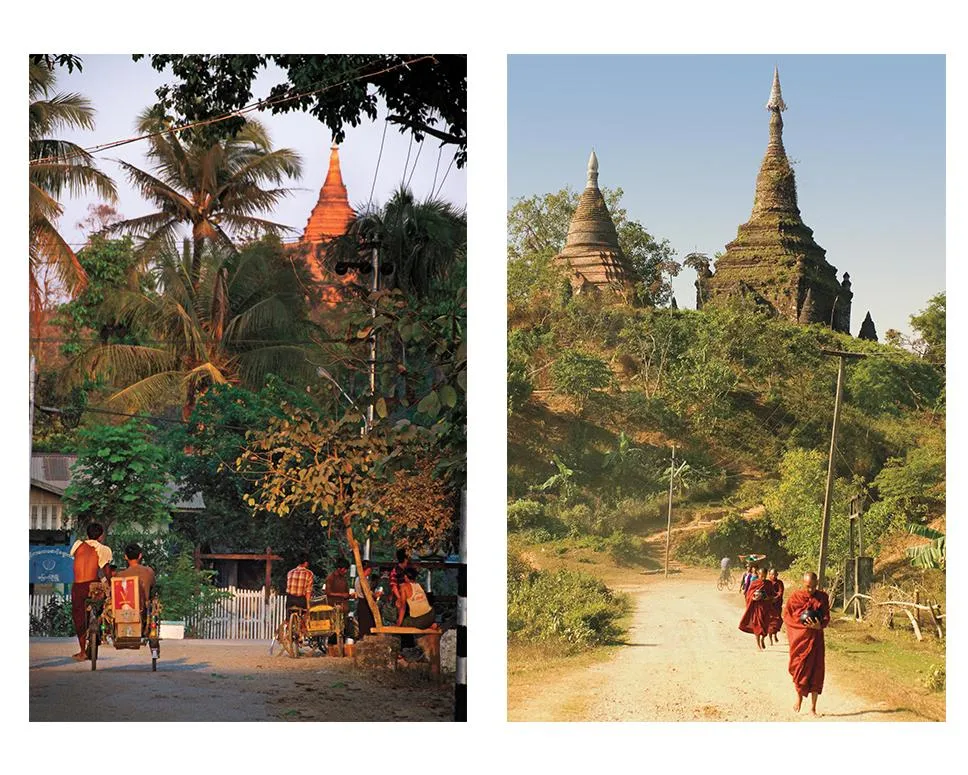
Right, Mrauk U residents live amid ancient splendors. Myanmar seeks Unesco designation for the site, unlikely to be granted until the violence ends. Paul Spierenburg / Laif / Redux; Piers Benatar / Panos Pictures
The new attention to Mrauk U has unleashed equally strong passions among the Arakan Buddhists, who see Mrauk U as the symbol of a great culture that was snuffed out by the Burmese. In 2014, Rakhine Buddhists received permission for the first time to commemorate publicly the fall of their capital. Thousands gathered at the site of Mrauk U’s Royal Palace—now little more than charred foundations—held marches, made speeches, and handed out food to Buddhist monks. But the government was wary of fueling another separatist movement in a country fractured by aggrieved minorities.
Three years later, police opened fire on a group of young protesters, killing seven, all of them in their teens and 20s, and injuring 12. One protester, whose name has been withheld to conceal his identity, was shot in the shoulder and watched one of his former schoolmates die a few feet away. “They showed haste. They could have shot with rubber bullets,” he told me. He, and many of his friends, he said, now support the Arakan Army, the Rakhine rebel group formed in 2009. It claims to have recruited 7,000 soldiers—far more than the Rohingya rebels—and has carried out dozens of attacks against Myanmar military and police in recent months.
By the summer of 2019, clashes between the Arakan Army and the Myanmar military, known as the Tatmadaw (armed forces), were breaking out near the temples, wiping out Mrauk U’s small tourism industry and forcing international consultants to withdraw. A Burmese source, whose name has also been withheld for protection, describes the situation as it has unfolded: “cut-off internet, troops carrying out tight surveillance in and around temples, abuses to civilians including arrest and torture over suspicion [of association with the Arakan Army]. Tatmadaw soldiers have taken [up positions] in most hills in and around town.” In August, following a rebel assault on an infantry base near Mrauk U, the Tatmadaw launched Hellfire missiles from attack helicopters and used artillery to bombard Arakan Army emplacements near Mrauk U town. (Reports indicate that vibrations from shelling may have damaged the temples.)
* * *
The majesty of Mrauk U remains undeniable. Nearing sunset one day, Zaw Myint and I paid about $1 to an enterprising tea shop owner whose property extends up one of the tallest hills. We ascended a winding wooden staircase behind his hut to an observation point. In the fading light, I gazed west over jungle-covered outcroppings, a complex of square-based temples and a giant stupa in a clearing just below us, scatterings of tin-roofed wooden houses interspersed among the ruins, and, six miles away, silhouetted by the orange sun, pagoda spires rising on a low crest beside the Kaladan River. Wouter Schouten, a Dutch physician, enjoyed a similar view when he arrived here during the reign of Sandathudamma, who ruled from 1652 to 1684. “When we ascended sufficiently high up the mountain we could descry the city of Aracan and the golden roofs of the palace, which shone magnificently in the rays of the sun,” he wrote in a memoir of his travels. “Here and there both on the mountain itself and in the valleys the eye fell on many pagodas, which made the view most enchanting...indeed, it would be difficult to imagine a more entrancing landscape.”
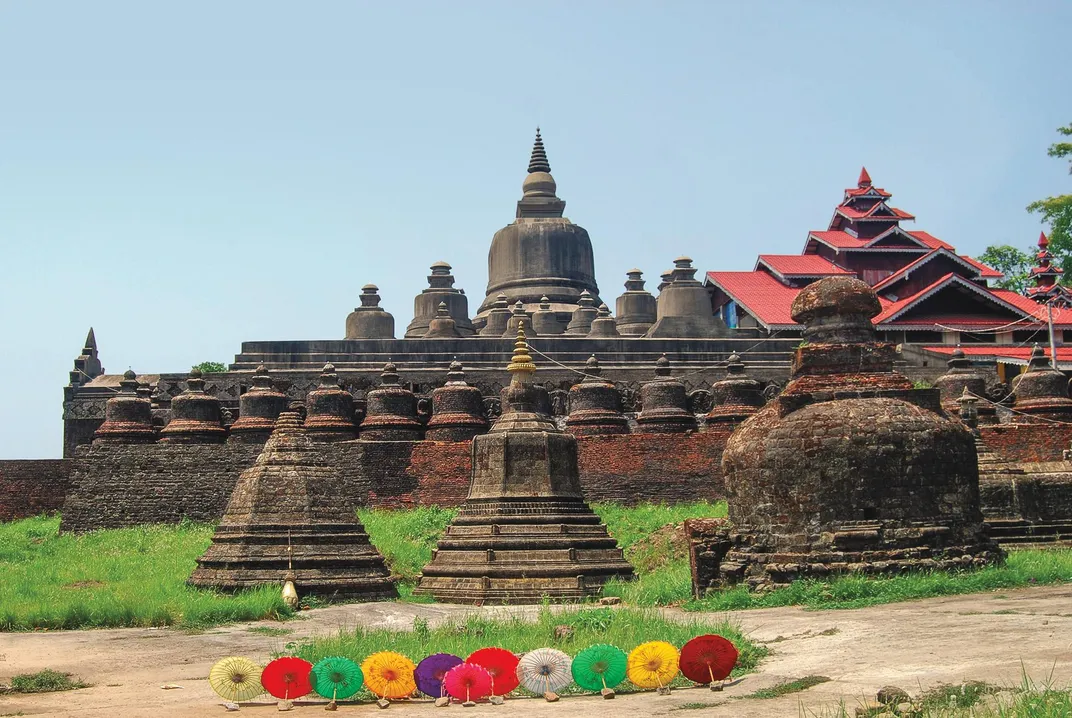
Daulat Qazi, a Bengali poet who lived here during the reign of Sirisudhammaraja in the 1620s, described a peaceful capital where “no one is envious of each other....Nobody is in distress and all the people are happy through the grace of the king.” One day he accompanied the monarch on a hunting expedition in the forest beyond the city, observing a dazzling display of pageantry that revealed Mrauk U in its splendor: “Elephants of diverse colours were with him. Coloured flags covered the sky. Thousands and thousands of soldiers and horses, without a limit to their number also followed him,” he wrote. “The glory of the king’s boat was beyond measure....Its pillars were of emerald and the roof was of silver.”
Centuries later, Leider, the scholar-adventurer, has been following in the footsteps of these intrepid travelers, seeking traces of the wonders that they discovered. With no sign of peace in sight, however, it’s unclear when he or other scholars and representatives of peaceful international organizations will return. And until they do, their plans and hopes for recapturing a semblance of Mrauk U’s past glory will remain in limbo.
/https://tf-cmsv2-smithsonianmag-media.s3.amazonaws.com/filer/17/fa/17faf713-2e48-4463-a022-418deef77872/myanmar_mobile.jpg)
/https://tf-cmsv2-smithsonianmag-media.s3.amazonaws.com/filer/47/91/4791e3ee-020a-42f1-8e44-83d4d169c206/a__opener_mraukuburma_lfov3.jpg)
/https://tf-cmsv2-smithsonianmag-media.s3.amazonaws.com/accounts/headshot/Screen_Shot_2021-09-15_at_12.44.05_PM.png)
/https://tf-cmsv2-smithsonianmag-media.s3.amazonaws.com/accounts/headshot/Screen_Shot_2021-09-15_at_12.44.05_PM.png)